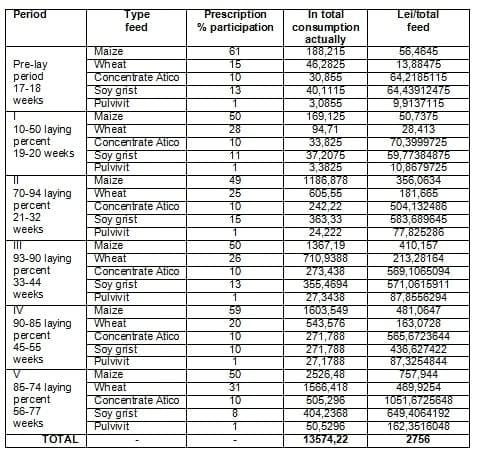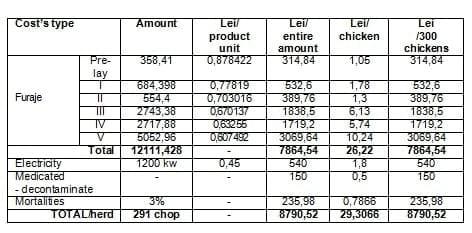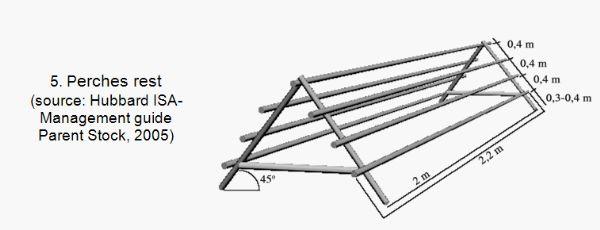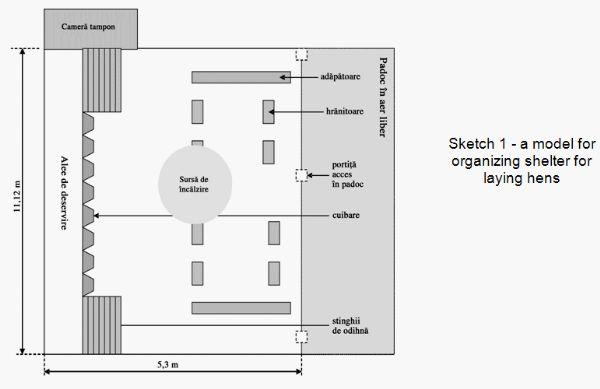Laying Hens Breeding
Alternatives to Laying Hens Breeding in Peasant Households
Published: December 30, 2011
By: Stafie Leonard (The Professional Association of Poultry Breeders in Iasi County)
INTRODUCTION
If we consider that the most research studies and debates are directed to big exploitations and producers in poultry industry (both eggs and meat production), who have the financial possibilities to employ specialists and who have a wide variety of poultry tools and equipments, then we may say that the middle and small producers are kind of deprived of accessing high technologies in this field. Lack of money, the economical incapacity to contract long-term credits, as well as the internal instability on our markets, are the main category of reasons which cause the lower investments in these type of farms, no matter of production direction. That´s why I´ve considered extremely necessary to study and to write articles and papers about improving the specific works in poultry farms, about a minimum level of technology, machinery and equipments, presenting in the same time some offers for inputs and biological sources.
We are two years after Romania joins the European Union and the peasant households are the same. If we refer to populations of birds in these "farms" to discuss effective up to 100 head, low productive birds, lack of application of sanitary veterinary rules, lack of technology and a feeding defect. Under these conditions and negative economic profitability of these farms is reflected directly in the living standard of "farmers". As a possible improvement of farm households, especially given that no financial resources for development of large farms, the first step to be done is to make upwards of existing farm with a minimum investment.
MATERIAL AND METHOD
This study was held in several householdings in Iasi county, in different villages, under financial limitations, but where the peasants were intending to improve and make more profitable the existing laying hens'''' breeding system.
The researched was relied on some minimum but essential measures:
- actual birds specialized on a specific production (eggs in our case);
- minimum number of 300 head;
- compliance with a minimum of technical operating and maintenance;
- compliance with minimum health requirements.
Minimum standards of maintenance and operation of laying hens are governed by Rule of 28/11/2001 Published in the Official Gazette, Part I no. 113 of 12/02/2002 and the Council Directive 1999/74/EC of 19 July 1999 laying down minimum standards for the protection of laying hens. Provisions of these rules shall not apply to holdings with fewer than 350 laying hens, farms growing youth replacement for laying hens.
By analytic method of efficiency calculating and based on the zootehnic patterns in this study, I analyzed the available materials in every household, observing, identifying and adjusting them to breeding systems that I determined and I decided to be the best solution for that medium or small farm. All the steps I made together with these breeders/peasants were relied on the existing rules and reglamentations for laying hens rising and wellness.
The results and economic values for efficiency were determined by some formulas and efficiency index from specialized scientific papers.
RESULTS AND DISCUSSIONS
To manage food systems can be used for feeding linear or circular but they face to ensure feeding of at least 10 cm/bird (feeding linear system) or 4 cm/bird (feeding system of circular). (1. System Photo - drink and feed, source: www.flytesofancy.co.uk) If the drink is water use plants with continuous drinking linear system (front watering the minimum 2.5 cm/bird) circular drinking system (front to drink minimum 1 cm/bird) and when using the drinking cup or pipe tip, will provide a cup or pipe up to 10 hens. To lay a nest is used for up to 7 hens (2. Photo. 2 model nest, source, Hubbard ISA Parent Stock Management Guide, 2005) and nests in the group to have at least one m2 for a maximum of 120 hens. Perches rest will be no sharp edges and allocate at least 15 cm/bird. They will not be placed above the litter, the distance between the perch at least 30 cm distance between the wall and the perch of 20 cm and the bedding should be at least 25 cm2/bird.
For the operation of laying hens with access to paddock (Photo 3, 4 paddock source model, www.chicken house.co.uk, 2007) breeder should take into consideration the following:
- Access birds in paddock is made by trap size 35 cm high and 40 cm wide arranged throughout the length and shelter as a general rule should be for 1000 chickens an opening of at least 2 m;
- bird density should not exceed 9 laying hens/usable area in m2.
Farmers´ duties
- The number of birds will be viewed as obligatory at least once a day
- You will avoid sudden noises, and noise level should be reduced to the minimum possible, feeding facilities, air conditioning and other equipment will be used so as to produce as little noise;
• Lights will be uniform and at a level at which birds can be seen in the case of using natural light, admission of light must be located so as to ensure uniformity of light distribution;
• All parts and equipment shelters that are in contact with poultry should be cleaned and decontaminated effectively.
Livestock buildings, shelters poultry must meet the following general criteria:
- satisfaction of conditions imposed by the specific biological process poultry populations;
- making microclimate conditions of the specific activity of growth and exploitation of birds (humidity, chemical factors, variations temperature, etc..)
- resistance in construction time, the possibility of rehabilitation of the profile for which the building was designed;
- construction costs as lower.
Shelters for poultry, livestock are designed to increase the construction and operation of meat or poultry laying hens. Analyzing the data presented, set design parameters for the production halls: spaţiiile for birds, buffer chamber, the inside of the shelter, microclimate conditions (temperature, humidity, air speed, lighting, etc..), The feeding, watering, etc.. In the case of new developments to increase farm birds should be considered a set of rules to be followed to maintain good health staff to comfort the people of the area and last for conducting the optimum technological processes.
Thus for calculating the surface shelter, that we need to herds of laying hens, are taken into account:
1. The overall
2. chick /m2
3. Area occupied by machinery (plus wholesome drinking).
Formula for calculation is applied to the following:
St = Su + SNP Where: St.
- is the total area of the shelter should be ensured for the growth and operation of poultry and existing machinery required for the production;
- Su area is occupied by machinery for feeding and watering equipment for, which calculates the relationship with Su = Nru × Sut where Nru represents the total number of machines placed in the hall and Sut m2 area is occupied by a single machine;
• SNP - is effectively used by the birds obtained by the relationship SNP = Et : Dp/m2where Et represents the overall population and for holding Dp/m2 mean density per m2.
From the town hall production for laying hens category appear nest, rest and Perches lane access for harvesting eggs. To maintain a state of good health for poultry and recommend arranging a paddock to be very grass have bower. Access to the paddock is made freely access via hand or mechanically. They have size 50/50 cm. In case of cold or wet paddock access is prohibited. As a surface for paddock must provide at least 6 square feet for a bird.
Raising youth replacement (0-19 weeks)
On the arrangement livestock equipment, shelters for youth category replacement are identical as for chicken meat.
Growing and operation of laying hens (20-77 weeks)
For a shelter with a capacity of 300 heads laying hens, density of 6.9 birds/m2 we need the following areas:
St = 58.925m2 where Su = 8.925m2 and SNP = 50m2
Shelter capacity of 300 heads laying hens, must have the following dimensions: length 11.12 m and 5.3 m in width and height of 2.2 m. From the town hall production for laying hens category appear nest, rest Perches passage and access for harvesting eggs. To maintain a state of good health for poultry and recommend arranging a paddock to be very grass have bower. Access to the paddock is made freely access via hand or mechanically. They have size 50/50 cm. In case of cold or wet paddock access is prohibited.
The numinous to ensure front feeding is 8 pieces and drinking 2 pieces and 50 nest (6 laying hens on a nest). In draft 1 - a model for organizing shelter for laying hens is presented an overview of the equipment arrangement.
You mentioned that the dimensions shown above are indicative, they may change depending on the density of birds per square meter of surface area and equipment used. In terms of density is considered that a density of 5 7 laying hens/m2 is sufficient. Problems occurred due to overloading density. Density too high can cause uneven growth of the number of birds, unable to ensure front feeding and watering, low percentage of lay. and rapid deterioration of permanent litter. Standing litter deterioration leads to a precarious state of health of herds of birds. For this reason had to be very careful in calculating the optimal use of space used by birds as failing this goal leads to important economic losses. If small number of birds (300 head) can use existing spaces in households, but must meet criteria on the optimal size, height (2 2.5m), is well insulated and heat to be easily cleaned and decontaminated.
Perches rest
Perches rests are placed in the halls of exploitation of laying hens, but the name you can tell by their role. Construction and dimensions as in photo 5 is played the necessary details. Perches rest are built of wood or other materials, but must be resistant to the weight carried by birds, are resistant to chemical corrosion factors of shelter and easily washable.
Economic calculations
Table 1
Recipes used forage consumption and feed for a herd of 300 heads laying hens, for 0 to 16 weeks

Price finished feed: 6 weeks starting 0:0.878422 lei/kg, 12 weeks Growth 7: 0.77819 lei/kg, 16 weeks and Development 13: 0.703016 lei/kg.
Ingredients´price: Maize 0.3 lei/kg, wheat 0.3 lei/kg Conc. Atico type chicks 0-7 weeks 2.2848 lei/kg Conc. Atico type chicks 7-18 weeks 2.2848 lei/kg Soy grist 1.6065 lei/kg Pulvivit 3.2130 lei kg.
Table 2
Cost of a herd of 300 heads laying hens 16 weeks period 0

Table 3
Recipes fodder used for the consumption of feed a herd of 300 heads laying hens, 17 to 77 weeks

Price finished feed: Pre lay 17-18 weeks: 0.670137 Euro/kg I, 10-50% lay, 19-20 weeks: 0.645079 Euro/kg, II, 70% lay 94, 21, 32 weeks: 0.695195 ROL/kg, III, 93% lay 90, 33, 44 weeks: 0.670137 Euro/kg, IV, 90 85% lay 45, 55 weeks: 0.63255 Euro/kg, V, 85% lay 74, 56, 77 weeks: 0.607492 Euro/kg.
Ingredients´price: Maize 0.3 lei/kg, wheat 0.3 lei/kg Conc. Atico type Layer 2.0813 lei/kg soybean groats 1.6065 lei/kg, Pulvivit 3.2130 lei/kg.
Table 4
Cost of a herd of 300 heads laying hens, 77 weeks from 17

Table 5
Total costs for 0 to 77 weeks/owner

CONCLUSIONS
This model is a top holding for development peasant household at the moment in a continuous decline. Respecting minimum standards, the products obtained can be traded legally, which means more income and higher capitalization of existing feed resources. The first step you should do "farmer" is holding and making effective use of human and material resources. We have no claim that all breeders to become laying hens or chicken meat and that is a solution for some people in rural areas.
Following the presentation of data on expenditure on a number of 300 laying hens that an egg costs 0143 lei. The price of wholesale will be approximately 0.25 lei, which means a net income of 0107 lei / or total income achieved in 77 weeks is 8784.7856 lei. A holding of this type provide an additional income producer. One thing very important: they are valued higher forage resources obtained by them (eg maize).
REFERENCES
1. Decun, Mihai, 2006: Amplasarea judicioasă a feremelor zootehnice, Referat Revista Ferma.
2. Peştişanu, Constantin şi col., 1981: Construcţii civile, industriale şi agricole, Ed. Didactică şi Pedagogică, Bucureşti.
3. Stafie, C., Leonard şi col., 2005: Ghid de Creştere a Găinilor Ouătoare, Ed. Waldpress, Timişoara.
4. Stafie, C., Leonard şi col., 2006: Ghid de mecanizare şi automatizare a adăposturilor de păsări, Ed. Waldpress, Timişoara.
5. Ştefanescu, Gheorghe si col., 1999: Creşterea păsărilor în fermele mici şi mijlocii, Ed. Ceres, Bucureşti.
6. Stoica, I., 1997: Nutriţia şi Alimentaţia Animalelor, Ed. Coral-Sanivel, Bucureşti.
7. Vacaru-Opriş, Ioan şi col., 2002: Tratat de Avicultură, vol. II, Ed. Ceres, Bucureşti.
8. Vacaru-Opriş, Ioan şi col., 2004: Tratat de Avicultură, vol. III, Ed. Ceres, Bucureşti.
9. Vacaru-Opriş, Ioan şi col., 2005: Sisteme şi Tehnologii de Creştere a Puilor de Carne, Ed. Ceres, Bucureşti.
10. ***** Hubbard Isa, 2002: Babcock 300, Management guide.
11. ***** Hubbard Isa, 2000: Babcock 380, Performance Standars.
12. ******Hubbard Isa, 2005: Management guide Parent Stock.
13. *****HY-Line Brown, 2004: Tehnologie de exploatare a găinilor ouătoare.
ILLUSTRATIONS APPENDIX




Related topics:
Authors:
Recommend
Comment
Share

Would you like to discuss another topic? Create a new post to engage with experts in the community.








.jpg&w=3840&q=75)